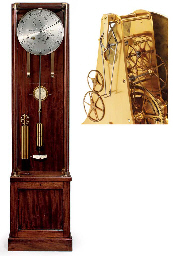A RARE VICTORIAN MAHOGANY CASED ELECTROMAGNETIC WIND DIRECTION INDICATOR ALFRED APPS, LONDON, CIRCA 1880 The lacquered brass and mahogany mechanism comprising a pair of opposing electromagnetic coil solenoids with pivoted arms acting on ratchets fitted to the same arbor mounted above, shunting it in either a clockwise or anticlockwise direction against a sprung sixteen-toothed wheel to check the increment of each rotation, the 8 inch circular silvered dial inscribed GORDONS, PATENT, APPS, OPTICIAN, 433 STRAND, LONDON within outer track annotated with the sixteen cardinal points of the compass with arrow markers to inner track, with single arrow hand within canted silver surround set behind a fixed glazed cast bezel secured vial screws to the outer flange, the rectangular case with hipped roof superstructure and cushion top moulding over visible screws flanking the dial to front, the left hand side with three brass electrical connection posts and the right with bone plunger for manual adjustment of the dial, the rear with upwards sliding panel, on generous cavetto moulded skirt base. 44.5cm (17.5ins) high, 37cm (14.5ins) wide, 28.5cm (11.25ins) deep. Alfred Apps is recorded in Banfield, Edwin BAROMETER MAKERS AND RETAILERS 1660-1900 as an optician, mathematical and philosophical instrument maker working from '433 West Strand, Near Charing Cross Railway Station, London' 1864 until after 1900. The Science Museum website lists him as working also as an electrical instrument maker who worked until 1911 when the business was succeeded/absorbed by Newton and Company. The present instrument appears to have been designed to work in conjunction with a weathervane fitted with a conforming mechanism designed to transmit electrical pulses as it is rotated by a change in direction of the wind. The three electrical connections would be for a common pole and then for pulses sent to either one of the solenoids for moving the arbor in a clockwise or anti-clockwise direction in an increment equal to a one-sixteenth rotation. From the quality of the construction and finish it is highly likely that the instrument was intended for installation into a wealthy environment, whether it be the boardroom of a maritime transport firm or the hallway of substantial country house. Despite the best efforts of the cataloguer we have been unable to find any further information relating to 'Gordons Patent' design of wind direction apparatus.
A RARE VICTORIAN MAHOGANY CASED ELECTROMAGNETIC WIND DIRECTION INDICATOR ALFRED APPS, LONDON, CIRCA 1880 The lacquered brass and mahogany mechanism comprising a pair of opposing electromagnetic coil solenoids with pivoted arms acting on ratchets fitted to the same arbor mounted above, shunting it in either a clockwise or anticlockwise direction against a sprung sixteen-toothed wheel to check the increment of each rotation, the 8 inch circular silvered dial inscribed GORDONS, PATENT, APPS, OPTICIAN, 433 STRAND, LONDON within outer track annotated with the sixteen cardinal points of the compass with arrow markers to inner track, with single arrow hand within canted silver surround set behind a fixed glazed cast bezel secured vial screws to the outer flange, the rectangular case with hipped roof superstructure and cushion top moulding over visible screws flanking the dial to front, the left hand side with three brass electrical connection posts and the right with bone plunger for manual adjustment of the dial, the rear with upwards sliding panel, on generous cavetto moulded skirt base. 44.5cm (17.5ins) high, 37cm (14.5ins) wide, 28.5cm (11.25ins) deep. Alfred Apps is recorded in Banfield, Edwin BAROMETER MAKERS AND RETAILERS 1660-1900 as an optician, mathematical and philosophical instrument maker working from '433 West Strand, Near Charing Cross Railway Station, London' 1864 until after 1900. The Science Museum website lists him as working also as an electrical instrument maker who worked until 1911 when the business was succeeded/absorbed by Newton and Company. The present instrument appears to have been designed to work in conjunction with a weathervane fitted with a conforming mechanism designed to transmit electrical pulses as it is rotated by a change in direction of the wind. The three electrical connections would be for a common pole and then for pulses sent to either one of the solenoids for moving the arbor in a clockwise or anti-clockwise direction in an increment equal to a one-sixteenth rotation. From the quality of the construction and finish it is highly likely that the instrument was intended for installation into a wealthy environment, whether it be the boardroom of a maritime transport firm or the hallway of substantial country house. Despite the best efforts of the cataloguer we have been unable to find any further information relating to 'Gordons Patent' design of wind direction apparatus.















Try LotSearch and its premium features for 7 days - without any costs!
Be notified automatically about new items in upcoming auctions.
Create an alert